|
|
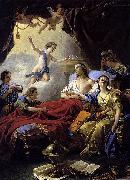 |
Louis Jean Francois Lagrenee
|
|
(December 30, 1724 - June 19, 1805) was a French painter, a pupil of Carlo Vanloo. His younger brother Jean-Jacques Lagren??e was also a painter.
Lagrenee was born in Paris. In 1755 he became a member of the Royal Academy, presenting as his diploma picture the Rape of Deianira (Louvre). He visited Saint Petersburg at the call of the empress Elizabeth, and on his return was named in 1781 director of the French Academy in Rome, a position he kept until 1787. He there painted the Indian Widow, one of his best-known works.
In 1804 Napoleon conferred on him the cross of the l??gion d'honneur, and on June 19, 1805 he died in the Louvre, of which he was honorary keeper.
|
|
|
|
|
|
 |
Louise Jopling
|
|
(16 November 1843 - 19 November 1933) was an English painter of the Victorian era, and one of the most prominent women artists of her generation.
Louise Goode was born in Manchester, fifth child of railway contractor T. S. Goode. She married at seventeen to civil servant Frank Romer. The Baroness de Rothschild, a connection of Romer's, encouraged Louise to pursue and develop her art. In the later 1860s she studied in Paris with Charles Joshua Chaplin and Alfred Stevens, and first exhibited her work at the Salon. She entered works into the Royal Academy shows, 1870-73 (as Louise Romer). |
|
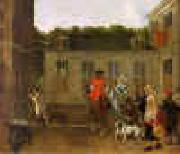 |
Ludolf de Jongh
|
|
1616-1679
Dutch
Ludolf de Jongh Galleries
Dutch painter. He was one of the most versatile Dutch painters of the 17th century, producing portraits, genre paintings of both domestic scenes and soldier life, landscapes with hunting scenes and a few historical subjects. According to Houbraken, he studied with Cornelis Saftleven in Rotterdam, Anthonie Palamedesz. in Delft, and Jan van Bijlert in Utrecht. In 1635 he went to France, where he stayed for seven years. His earliest known paintings are portraits and genre subjects that date from after his return to Rotterdam in about 1642 and strongly reflect the style of Palamedesz.'s work. The genre subjects and numerous hunting scenes (e.g. Riders before an Inn; Geneva, Mus. A. & Hist.) painted shortly before the 1650s show the influence of van Bijlert and other Utrecht painters, especially Jacob Duck and Dirck Stoop. |
|
|
|
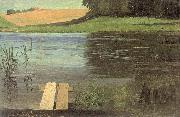 |
Lundbye, Johan Thomas
|
|
Danish Painter, 1818-1848
Danish painter. He studied at the Kongelige Akademi for de Sk?nne Kunster, Copenhagen, under Johan Ludvig Lund (1777-1867) and the animal painter Christian Holm (1804-46) between 1832 and 1842. Early on he was influenced by the ideas of the art historian N. L. H?yen, especially his concept of a truly national school of landscape painting. Kalundborg Church (1837; Copenhagen, Stat. Mus. Kst) depicts a historical monument familiar to all Danes, and one that had a particular nostalgic attraction for a painter born in Kalundborg. The picture is both sharply naturalistic and emphatically painterly. In Landscape Near Arres? (1838; Copenhagen, Thorvaldsens Mus.) Lundbye was more occupied with the representation of light and space. There is no anecdotal element; the lake, the open sky, the low hills, the ancient cairn, the cattle and the playing children sum up a typical Danish summer landscape. His larger canvases emphasize openness; flat expanses of land terminate in low tree-fringed horizons below vast skies. They have little of Constable's temperament or the broadness of Corot but are close to the elegiac mood of Caspar David Friedrich and Johan Christian Dahl. Danish landscape painting during the mid-1830s was greatly influenced by Romanticism |
|
|
|
|
|
|
|
|
|
|
|
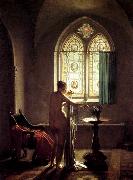 |
MALLET, Jean-Baptiste
|
|
French Painter, 1759-1835,French painter. A pupil of Simon Julien in Toulon, he was then taught by Pierre-Paul Prud'hon in Paris. He exhibited at every Salon between 1793 and 1827, obtaining a second class medal in 1812 and a first class medal in 1817. He executed very few portraits (Chenier, Carcassonne, Mus. B.-A., is an exception), preferring to paint nymphs bathing and graceful classical nudes such as the Graces Playing with Cupid (Arras, Abbaye St Vaast, Mus. B.-A.). He established his reputation with gouache genre scenes of fashionable and often libertine subjects, always elegant and refined, in the style of Louis-Philibert Debucourt and Louis-Leopold Boilly, and remarkable for the delicacy and brilliance of their brushwork: for example At the Laundry Maid's and the Painful Letter (both Paris, Mus. Cognacq-Jay). They reveal a knowledge of 17th-century Dutch painting in the treatment of details (transparent crystal, reflections on silk or satin) as well as the choice of themes: Military Gallant (Paris, Mus. Cognacq-Jay). Mallet's meticulously precise paintings are one of the best records of fashionable French furnishings and interiors at the end of the 18th century and the beginning of the 19th. |
|
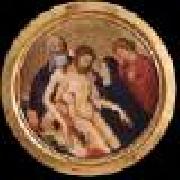 |
MALOUEL, Jean
|
|
Netherlandish Gothic Era Painter, ca.1365-1415
North Netherlandish painter, active in Burgundy. He was the son of the heraldic artist Willem Maelwael and uncle of the Limbourg brothers. First recorded as a painter in 1382, he is then documented on 20 September 1396 for a commission to provide designs for textiles with decorative armorial bearings for Queen Isabeau of Bavaria, wife of Charles VI, for which he received payment on 27 March 1397. By 5 August 1397 he was in Dijon, where he succeeded Jean de Beaumetz as court painter and Valet de Chambre to Philip the Bold, Duke of Burgundy. Malouel was highly paid, and his annual pension was considerably more than that of Beaumetz or of the sculptor Claus Sluter. One of the first works Malouel produced for the Duke was a painting of the Apostles with St Anthony (untraced), paid for on 11 November 1398, which the Duke is known to have kept in his private oratory. On 18 March 1398 wooden supports were purchased for Malouel to paint five large altarpieces for the Charterhouse of Champmol, outside Dijon. The subject-matter of the paintings is not specified in the document, although the dimensions of the panels are given. The Martyrdom of St Denis (Paris, Louvre; for illustration see BELLECHOSE, HENRI) has been identified as one of these five panels, on the basis of its possible provenance and its dimensions, which correspond approximately to those given in the document. In May 1416, however, Henri Bellechose received pigments to 'perfect' a painting of the Life of St Denis, and this document, in conjunction with the earlier one, has been interpreted to suggest that Bellechose completed a work left unfinished by Malouel. |
|
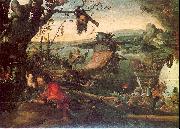 |
Mandyn, Jan
|
|
Dutch Northern Renaissance Painter, ca.1500-1560 |
|
|
|
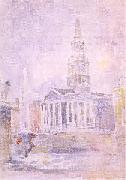 |
Marin, John
|
|
American Painter, 1870-1953
American painter and printmaker. He attended Stevens Institute in Hoboken, NJ, and worked briefly as an architect before studying at the Pennsylvania Academy of the Fine Arts in Philadelphia from 1899 to 1901 under Thomas Pollock Anshutz and Hugh Breckenridge (1870-1937). His education was supplemented by five years of travel in Europe where he was exposed to avant-garde trends. While abroad, he made etchings of notable and picturesque sites |
|
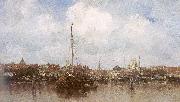 |
Maris, Jacob
|
|
Dutch, 1837-1899
was a Dutch painter, who with his brothers Willem and Matthijs belonged to what has come to be known as the Hague School of painters. Maris studied at the Antwerp Academy, and subsequently in Hubertus van Hove's studio during a stay in Paris from 1865 till 1871. He returned to Holland when the Franco-Prussian War broke out, and died there in August 1899. Though he painted, especially in early life, domestic scenes and interiors invested with deeply sympathetic feeling, it is as a landscape painter that Maris excelled. He was the painter of bridges and windmills, of old quays, massive towers, and level banks; even more was he the painter of water, and misty skies, and chasing clouds. In all his works, whether in water or oil color, and in his etchings, the subject is always subordinate to the effect. His art is suggestive rather than decorative, and his force does not seem to depend on any preconceived method, such as a synthetical treatment of form or gradations of tone. And yet, though his means appear so simple, the artist's mind seems to communicate with the spectator's by directness of pictorial instinct, and we have only to observe the admirable balance of composition and truthful perspective to understand the sure knowledge of his business that underlies such purely impressionist handling. Maris has shown all that is gravest or brightest in the landscape of Holland, all that is heaviest or clearest in its atmosphere for instance, in the " Grey Tower, Old Amsterdam," in the " Landscape near Dordrecht," in the " Sea-weed Carts, Scheven-ingen," in " A Village Scene," and in the numerous other pictures which have been exhibited in the Royal Academy, London, in Edinburgh (1885), Paris, Brussels |
|
|
|
|
|
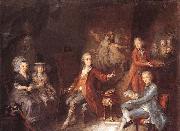 |
Martin Johann Schmidt
|
|
Austrian Painter, 1718-1801,was one of the most outstanding Austrian painters of the late Baroque/Rococo along with Franz Anton Maulbertsch. A son of the sculptor Johannes Schmidt and a pupil of Gottlieb Starmayr, he spent most of his life at Stein, where he mostly worked in the numerous churches and monasteries of his Lower Austrian homeland. While the evolution of his style after 1750 shows that he had either spent a formative period in northern Italy or had at least had extensive contact with northern Italian works of art prior to that date, his works are also clearly influenced by Rembrandt (visible above all in his etchings) and the great fresco-painters of the Austrian Baroque, Paul Troger and Daniel Gran. Despite not having received formal academic training, in 1768 he was made a member of the imperial academy at Vienna due to his artistic merits, which by that time had already been recognized by a wider public inside and outside of Austria. Primarily he painted devotional images for private devotion and churches, including a considerable number of large altar paintings. His lively and colourful style made him extremely popular with people from all levels of society already during his lifetime. From 1780 mythological and low-life themes became increasingly frequent, only to be replaced by a renewed concentration on religious topics during the very last years of Schmidt's life. He was at that an important draughtsman and has left numerous etchings which clearly show Rembrandt's influence. While his earlier works typically show a warm chiaroscuro, from about 1770 he used increasingly stronger and more lively colours. Simultanueously, both his style and his brush technique became much more free, making him, like Franz Anton Maulbertsch, an important predecessor of impressionism. In this aspect, his mature style is completely contrary to neoclassicism, the style which increasingly dominated European art after about 1780. |
|
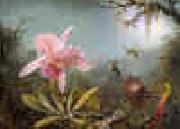 |
Martin Johnson Heade
|
|
American Hudson River School Painter, 1819-1904 Martin Johnson Heade (August 11, 1819-September 4, 1904) was a prolific American painter known for his salt marsh landscapes, seascapes, portraits of tropical birds, and still lifes. His painting style and subject matter, while derived from the romanticism of the time, is regarded by art historians as a significant departure from that of his peers.
Art historians have come to disagree with the common view that Heade is a Hudson River School painter, a view given wide currency by Heade's inclusion in a landmark exhibition of Hudson River School landscapes at the Metropolitan Museum of Art in 1987.
The leading Heade scholar and author of Heade's catalogue raisonn??, Theodore E. Stebbins, Jr., wrote some years after the 1987 Hudson River School exhibition that "...other scholars??myself included??have increasingly come to doubt that Heade is most usefully seen as standing within that school."
According to the Heade catalogue raisonn??, only around 40 percent of his paintings were landscapes. The remaining majority were still lifes, paintings of birds, and portraits, subjects unrelated to the Hudson River School. Of Heade's landscapes, perhaps only 25 percent were painted of traditional Hudson River School subject matter.
Heade had less interest in topographically accurate views than the Hudson River painters, and instead focused on mood and the effects of light. Stebbins writes, "If the paintings of the shore as well as the more conventional compositions...might lead one to think of Heade as a Hudson River School painter, the [marsh scenes] make it clear that he was not." |
|
|
|
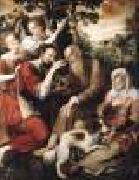 |
MASSYS, Jan
|
|
Netherlandish Painter, ca.1509-1575
Painter, son of Quinten Metsys. More so than his brother Cornelis Massys, who was a less talented artist, Jan worked in the style of his father, whose studio he may have taken over following his death in 1530. Two years later, though still under the age of majority, Jan was admitted as a master in the Guild of St Luke in Antwerp. Like Cornelis, he seems to have left Antwerp immediately after attaining the status of master, for he is not mentioned again in the archives. It has been suggested on stylistic grounds that he worked for a period at Fontainebleau, but this is disputed. He was, in any case, back in Antwerp by 1536, when he took on an apprentice, Frans van Tuylt. In 1538 he married Anna van Tuylt, by whom he had three children. |
|
|
|
|
|
|
|
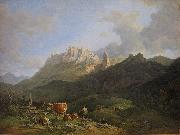 |
Max Joseph Wagenbauer
|
|
Maximilian Joseph Wagenbauer (1775 Grafing - 1829 Munich), was a Bavarian artist.
After finishing school, Wagenbauer attended drawing classes in Munich, under Johann Jakob Dorner the Elder (1741-1813). At the turn of the 19th century he was producing mostly Neo-Classical watercolour landscapes. He served in the military from 1797 to 1801, receiving a royal artist's annuity after his service through the influence of Johann Christian von Mannlich (1741-1822), architect and general building director of the dukes of Zweibre-ken. A condition of the royal stipend was that he produce paintings. He was appointed artist to the court and cabinet in 1802 and Inspector of the Royal Paintings Gallery in 1815. Wagenbauer focused increasingly on oil painting after 1810 and enjoyed the patronage of Maximilian I Joseph of Bavaria, who in 1811 commissioned him, Cantius Dillis (1779-1856) and Johann Jakob Dorner the Younger (1775-1852) to decorate the banquet hall at Schloss Nymphenburg with large paintings of Bavarian lakes. |
|
|
|
|
|
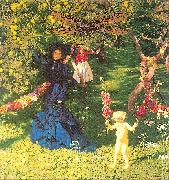 |
Mehoffer, Jozef
|
|
Polish, 1869-1946
was a Polish painter and decorative artist, one of the leading artists of the Young Poland movement and one of the most revered Polish artists of his time. Mehoffer studied painting at the Academy of Fine Arts in Krakew under Władysław Łuszczkiewicz, and later at the Academy of Fine Arts in Vienna as well as in Paris at the Academie Colarossi among others. There Mehoffer began painting portraits often of people of historical significance. He later expanded his work to include different techniques, such as graphic art, stained glass, textiles, chalk drawings, etchings and book illustrations. He produced set designs for theatre and stylized furniture designs. Mehoffer received international acclaim for his stained glass windows in the Gothic St Nicholas Collegiate Church in Fribourg, Switzerland produced in 1895-1936. His other stained glass designs include the Radziwill Chapel in Balice (1892), Grauer Chapel in Opava (1901), church in Jutrosini (1902), Holy Cross Chapel at Wawel (1904), sepulchral chapel in Goluchoew (1906), Orgelmeister Chapel in Vienna (1910), cathedral in Wloclawek (1935-40), cathedral in Przemysl (1940) and church in Debniki near Krakow (1943).There are stained glass designed by Mehoffer in Jesus Holliest Heart in Turek (East Greater Poland - central Poland) in the same church there are also mural paintings made by Mehoffer. Mehoffer explored various media further throughout his career to include a range of applied arts in his projects. He manufactured a multiplicity of book covers, ornaments and posters. |
|
|
|
|
|
Meyer, Jeremiah
|
|
English Painter, 1735-1789
German enameller and painter, active in England. He was the son of a portrait painter at the court of W?rttemberg. He arrived in England c. 1749 and studied in London at St Martin's Lane Academy and then (1757-8) under Christian Friedrich Zincke; as a result of this training, much of Meyer's early work was painted on enamel. He exhibited (1760-67) at the Society of Artists and in 1761 was awarded its gold medal for a profile portrait of George III. In 1762 he became a naturalized Englishman. That year he was appointed miniature painter to Queen Charlotte and in 1764 painter in enamel to the King. Meyer was a founder-member of the Royal Academy and exhibited miniatures, enamels and watercolours there (1769-83). |
|
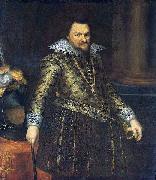 |
Michiel Jansz. van Mierevelt
|
|
(Delft, 1567 - Delft 27 June 1641) was a Dutch Golden Age painter.
He was the son of a goldsmith, who apprenticed him to the copperplate engraver Hieronymus Wierix. He subsequently became a pupil of Willem Willemz and Augusteyn of Delft, until Anthonie van Montfoort (Houbraken calls him Antony Blokland), who had seen and admired two of Mierevelt's early engravings, Christ and the Samaritan and Judith and Holofernes, invited him to enter his school at Utrecht.
He registered as a member of the Guild of St. Luke in The Hague in 1625.Devoting himself first to still lifes, he eventually took up portraiture, in which he achieved such success that the many commissions entrusted to him necessitated the employment of numerous assistants, by whom hundreds of portraits were turned out in factory fashion. Today over 500 paintings are or have been attributed to him.The works that can with certainty be ascribed to his own brush are remarkable for their sincerity, severe drawing and harmonious color, but comparatively few of the two thousand or more portraits that bear his name are wholly his own handiwork. So great was his reputation that he was patronized by royalty in many countries and acquired great wealth. The king of Sweden and the count palatine of Neuburg presented him with golden chains; Albert VII, Archduke of Austria, at whose court he lived in Delft, gave him a pension; and Charles I vainly endeavoured to induce him to visit the English court.
Though Mierevelt is chiefly known as a portrait painter, he also executed some mythological pieces of minor importance. Many of his portraits have been reproduced in line by the leading Dutch engravers of his time. He died at Delft.
The Rijksmuseum in Amsterdam has the richest collection of Mierevelt's works, chief of them being the portraits of William, Philip William, Maurice, and Frederick Henry of Orange, and of the count palatine Frederick V. At the Mauritshuis in The Hague are the portraits of four princes of the house of Orange, of Frederick V as king of Bohemia, and of Louise de Coligny as a widow. Other portraits by him are at nearly all the leading continental galleries, notably at Brunswick (3), Gotha (2), Schwerin (3), Munich (2), Paris (Louvre, 3), Dresden (4), Berlin (2), and Darmstadt (3). The town hall of Delft also has numerous examples of his work.
|
|
 |
Miel, Jan
|
|
Dutch Baroque Era Painter, ca.1599-1664
Flemish painter, active in Italy. Miel must have arrived in Rome in the early 1630s; he immediately came under the influence of Pieter van Laer (il Bamboccio) and the BAMBOCCIANTI. His earliest paintings of bambocciate (low-life scenes) are the Bowls Players (1633; Paris, Louvre) and its companion piece The Cobbler (Besan?on, Mus. B.-A. & Arch?ol.). Shortly after his arrival in Rome, Miel joined the Schildersbent, a confraternity of Netherlandish artists, and was given the nickname 'Bieco' ('threatening look'). His presence in Rome is documented from 1636 to 1658, when he moved to Turin and entered the service of Charles-Emanuel II, Duke of Savoy. Other early paintings that can be attributed to the 1630s include Halt at the Inn (Marseille, Mus. B.-A.) and Hunters' Rest (Warsaw, N. Mus.). Both are reworkings, in their subject-matter and composition, of contemporary paintings by van Laer |
|
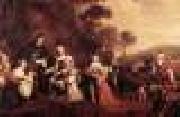 |
MIJTENS, Jan
|
|
Dutch Baroque Era Painter, ca.1614-1670
Nephew of Daniel Mijtens I. He was the son of Daniel's elder brother David, a saddle-maker in The Hague. Jan may have learnt to paint from his uncle Isaac Mijtens. After 1634 he may have trained with his uncle Daniel, who had by then returned to The Hague; Jan married Daniel's daughter Anna in 1642. In 1639 he had been admitted to The Hague's guild of painters, of which he became a governor in 1656. In the latter year he helped to found the painters' society De Pictura; from 1667-8 he was a governor of this society and from 1669-70 its dean. |
|
 |
Minerva Josephine Chapman
|
|
(1858 - 1947) was an American painter. She was known for her work in miniature portraiture, landscape, and still life.
She was born in Sand Bank, New York and grew up in Chicago, Illinois. She studied at a number of institutions including Mount Holyoke College (where she graduated from in 1880) and the Art Institute of Chicago. She lived and studied in Paris from the late 1880s to 1915, and again after the first world war, where she established her reputation as an artist. She retired to Palo Alto, California and died at the age of 88.
|
|
|
|
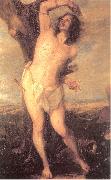 |
Miranda, Juan Carreno de
|
|
Spanish, 1614-1685
was a Spanish painter of the Baroque period. Born in Avil's in Asturias, son of a painter with the same name, Juan Carreño de Miranda. His family moved to Madrid in 1623, and he trained in Madrid during the late 1620s as an apprentice to Pedro de Las Cuevas and Bartolom Roman. He came to the notice of Velezquez for his work in the cloister of Doña Maria de Aragen and in the church of El Rosario. In 1658 Carreño was hired as an assistant on a royal commission to paint frescoes in the Alcezar palace, now the Royal Palace of Madrid. In 1671, upon the death of Sebastian de Herrera, he was appointed court painter to the queen (pintor de cemara) and began to paint primarily portraits. He refused to be knighted in the order of Santiago, saying Painting needs no honors, it can give them to the whole world. He is mainly recalled as a painter of portraits. His main pupils were Mateo Cerezo, Cabezalero, Donoso, Ledesma y Sotomayor. He died in Madrid. Noble by descent, he had an understanding of the workings and psychology of the royal court as no painter before him making, his portraits of the Spanish royal family in an unprecedented documentary fashion |
|
 |
MOLENAER, Jan Miense
|
|
Dutch painter (b. ca. 1610, Haarlem, d. 1668, Haarlem).
Dutch painter and draughtsman. The surprisingly large oeuvre of this remarkably versatile genre painter displays an inventive symbolism, wit and humour, which identify him as the true forerunner of Jan Steen. |
|
|
|
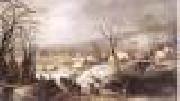 |
MOMPER, Joos de
|
|
Flemish painter (b. 1564, Antwerpen, d. 1634/35, Antwerpen).
also known as Josse de Momper, is one of the most important Flemish landscape painters between Pieter Brueghel the Elder and Peter Paul Rubens. Brueghel's influence is clearly evident in this many of de Momper's paintings. Born in 1564 in Antwerp, Joos de Momper was first apprenticed to his father. In the 1580s, he travelled to Italy to study art. De Momper primarily painted landscapes, the genre for which he was well-regarded during his lifetime. He painted both fantasy landscapes, viewed from a high vantage point and employing a conventional Mannerist color transition of brown in the foreground to green and finally blue in the background, and more realistic landscapes with a lower viewpoint and more natural colors. His wide panoramas also feature groups of figures. |
|
|
|
|
|
|
|
|
|
|
|
|
|
|
|
|
|
|

